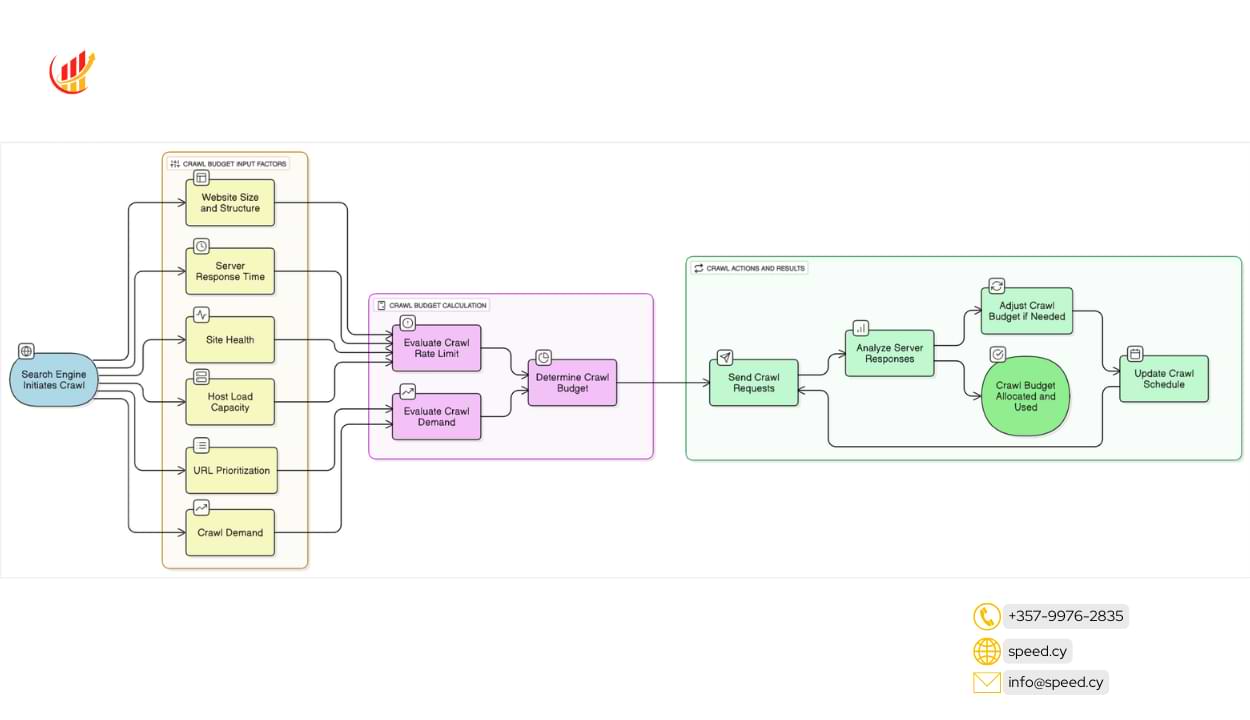What is Crawl Budget?
Crawl budget is the number of pages a search engine, like Google, will crawl on a website within a certain timeframe. Search engines have finite resources and cannot crawl every page on the internet constantly. Therefore, they allocate a “budget” to each website, which influences how many of its pages are discovered, crawled, and ultimately indexed.
Think of it like a budget Google allocates to each site – determining how much time its crawlers will spend exploring its pages. This doesn’t mean there’s a hard limit, but rather a combination of factors that influence crawling frequency.
While most small to medium-sized websites don’t need to be overly concerned with their crawl budget, it becomes a critical factor for large websites (over 10,000 pages), sites that add a lot of new pages frequently, and sites with technical issues.
Crawl Flowchart Explained
The flowchart correctly breaks down the process into three key stages: Input Factors, Calculation, and Actions and Results.
Crawl Budget Input Factors
This section accurately identifies the primary signals that search engines use to determine how to crawl a site.
-
Website Size and Structure: The size of a website directly impacts how much attention it will receive from crawlers. A well-organized structure, often facilitated by a flat page architecture and clear internal linking, helps search engine bots discover and crawl pages more efficiently.
-
Server Response Time: A faster server response time can lead to an increased crawl rate. If a site is slow or returns server errors, Googlebot will slow down its crawling to avoid overloading the server.
-
Site Health: This is a crucial factor. Frequent server errors (like 5xx errors) and a high number of broken links (404 errors) can negatively impact how a search engine perceives your site’s health, leading to a reduced crawl rate.
-
Host Load Capacity: Search engines are designed to be good citizens of the web and will limit their crawling rate to avoid overwhelming a website’s server. This is also referred to as the “crawl rate limit.”
-
URL Prioritization: The flowchart correctly implies that not all URLs are treated equally. Factors like the number of internal and external links pointing to a page signal its importance to search engines.
-
Crawl Demand: This is a key concept that the flowchart rightly highlights. It refers to how much a search engine wants to crawl a site. Crawl demand is primarily influenced by two factors:
-
Popularity: More popular URLs, often measured by backlinks and user traffic, are crawled more frequently to keep the content fresh in the index.
-
Staleness: Search engines aim to keep their index updated. Pages that are updated more frequently are likely to be crawled more often.
-
Crawl Budget Calculation
This section accurately depicts the core components of how the crawl budget is determined.
-
Evaluate Crawl Rate Limit: This corresponds to the “crawl health” and “host load capacity” factors. Search engines assess how quickly and reliably they can access a site’s content without causing issues.
-
Evaluate Crawl Demand: This aligns with the “URL prioritization” and “crawl demand” inputs. Search engines determine which pages are most important to crawl based on their popularity and how recently they’ve been updated.
-
Determine Crawl Budget: The flowchart correctly shows that the final crawl budget is a combination of the crawl rate limit and crawl demand.
Crawl Actions and Results
The final section accurately illustrates the ongoing process of crawling and refinement.
-
Send Crawl Requests: Based on the determined budget, the search engine sends its bots (like Googlebot) to fetch the pages.
-
Analyze Server Responses: The search engine continuously monitors how the server responds to its requests. This feedback loop is crucial for adjusting the crawl rate.
-
Crawl Budget Allocated and Used: This represents the actual crawling activity.
-
Adjust Crawl Budget if Needed: Based on the analysis of server responses, if a site is fast and healthy, the budget might be increased. If it’s slow or error-prone, the budget will be reduced.
-
Update Crawl Schedule: The entire process is dynamic. The crawl schedule is constantly being updated based on all the factors mentioned above.
Why Does Crawl Budget Matter for SEO?
A healthy crawl budget is crucial for SEO because it directly impacts how much of your content gets discovered and indexed by Google. If Googlebot doesn’t crawl your pages, they won’t appear in search results. This is particularly important for larger websites or those with frequently updated content. According to a 2022 study by Search Engine Journal, Googlebot crawls billions of pages every day. Ensuring your site is efficiently crawled helps maximize your visibility within this vast landscape.
Factors Influencing Crawl Budget
Several key factors contribute to your website’s crawl budget:
- Crawl Rate Limit: Google determines a crawl rate suitable for your site based on its overall health and server capacity.
- Crawl Demand: Popularity and freshness of content influence how often Googlebot revisits your pages.
- Website Architecture: A well-structured site with clear internal linking makes it easier for crawlers to navigate and discover content.
Optimizing Your Crawl Budget
Follow these steps to improve your crawl budget and SEO performance:
- Improve Site Speed: Faster loading times allow Googlebot to crawl more pages within its allocated time. Aim for a page load time under 2 seconds.
- Fix Crawl Errors: Regularly check Google Search Console for crawl errors like 404s and broken links. These errors waste crawl budget.
- Optimize Internal Linking: A logical internal linking structure guides crawlers to important pages and distributes link equity effectively.
- Submit a Sitemap: A sitemap provides Google with a roadmap of your website’s structure, helping it discover and index all important pages.
- Use Robots.txt Wisely: While robots.txt can block unwanted crawling, be careful not to unintentionally block important sections of your site.
Common Crawl Budget Myths
There are some misconceptions surrounding crawl budget. Let’s debunk a few:
| Myth | Reality |
|---|---|
| Small websites don’t need to worry about crawl budget. | Even small sites benefit from an optimized crawl budget to ensure all pages are indexed efficiently. |
| More backlinks automatically increase crawl budget. | While backlinks can signal importance, they don’t directly control Google’s crawl rate limit. |
Monitoring and Analyzing Crawl Budget
You can monitor your crawl budget within Google Search Console. Look for trends in crawl stats and address any spikes or dips in crawled pages. This data can offer insights into potential issues affecting your website’s crawlability.
“A well-optimized crawl budget ensures that search engines can efficiently discover and index your most important content, ultimately boosting your visibility in search results.” – Jesus Guzman, SEO Content Strategist
Conclusion
Understanding and optimizing your crawl budget is a crucial aspect of technical SEO. By addressing the factors that influence crawling and implementing best practices, you can help Googlebot efficiently index your site‘s content, leading to improved search rankings and increased organic traffic to speed.cy.



